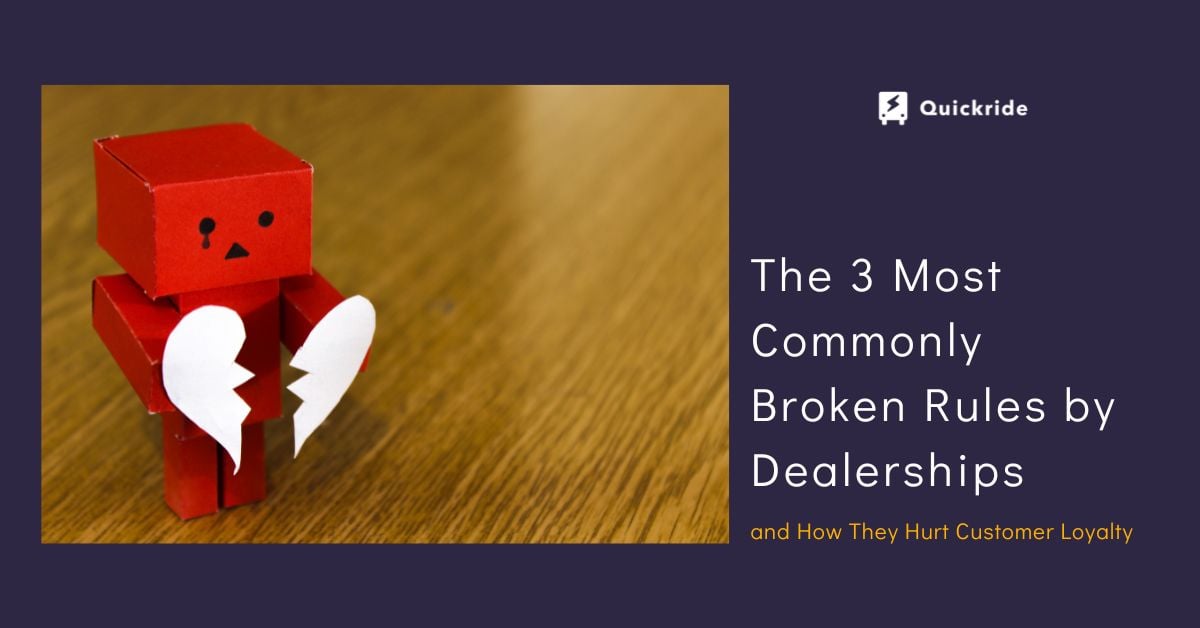
If you work in a dealership, then you are probably very familiar with the phrase "dealership rules." These rules can vary from one dealership to another, but they are often unwritten. In many cases, they are either not enforced or not understood by employees who have been there for years. These unspoken guidelines can create problems when they're broken by employees or vendors working on behalf of the company. If a customer finds out that one of these rules has been broken, it will certainly hurt their overall impression of your brand and could possibly lead them to leave negative reviews about your business online (which does more harm than good).
Rule #1 Under-deliver
Why it hurts:
This is a mistake that dealerships are all too familiar with. It's a mistake that even the best of us can fall into at times, but it's one we should all avoid at all costs. If your dealership is going to thrive, you need to make sure you're doing everything you can to keep your customers happy and satisfied—and that includes keeping your promises.
How you can fix it:
The first step in avoiding this pitfall is to make sure you have an effective customer service strategy in place; if your employees are empowered with the tools and training they need to do their jobs well, they'll be able to deliver on their commitments and keep customers happy. The second step is making sure that everyone on staff understands how important it is for them to follow through on those commitments: if someone knows there are consequences for not following through or for overpromising, they're less likely to break those rules! Finally, it's important to have an effective system in place for measuring customer satisfaction—that way you'll be able to identify when things aren't going well before they become big problems.
Rule #2 Under-communicate and over-promise
Why it hurts:
This is a big one, and it's one that's hard to see from the dealership's point of view. The problem with under-communicating and over-promising is that it creates a disconnect between the customer's expectations and what they actually get. For example, if you tell a customer that their car will be ready for pick-up in two days, but it actually takes three days, then that customer is going to feel like they've been lied to—and they probably won't come back to your dealership again.
When it comes to the automotive industry, time is money. Customers have a lot of options when it comes to cars, which means you have to work hard to keep them interested in your dealership. If you don't communicate clearly and consistently with your customers, they'll lose interest in your dealership and may never come back again.
How you can fix it:
Dealerships should implement a system that allows them to communicate with their customers in a consistent way throughout every step of the process. This can be done through email or text message notifications or by tracking calls in a CRM system. In addition, dealerships should also ensure that their employees are trained on how best to engage with customers and not over-promise or under-communicate when it comes to their needs.
Rule #3 Conflict of interest
Why it hurts:
Conflict of interest is one of the most common types of dealership violations. It can also be one of the most harmful to customer loyalty. A conflict of interest occurs when a dealership employee or vendor has a personal interest in a transaction that may cause them to make decisions in their own best interests instead of those of their customers.
This can happen in several ways:
- Employees may use the information they've gathered about a customer and their vehicle to purchase the same vehicle at another dealership or give that information to other employees who may do so.
- Dealership employees may recommend repairs or maintenance that aren't necessary, but profit the dealership more than they benefit the customer.
- Dealership employees may sell parts that are not compatible with an older model car, and then replace them with compatible parts after the sale.
How you can fix it:
The best way to avoid conflict of interest is through education. Make sure all employees understand what constitutes a conflict, and why customer satisfaction is more important than profit for your business. Communicate this message through company policies and procedures, and make sure all employees receive regular training on how to avoid conflicts when dealing with customers.
Also by reinforcing your dealership's mission statement and making sure that everyone knows that customer satisfaction is your number one priority. You can also help your employees understand how important it is to listen to customer concerns and make them feel valued at all times.
Conclusion
The bottom line is that dealerships need to follow the guidelines of their own brands and the best practices that have been proven to work. There are many ways to do this, including implementing proper training programs for employees and vendors who service customers’ cars, as well as conducting regular customer surveys so they can provide feedback on how they feel about their experiences at your dealership. These simple steps will help create a positive environment where people want to come back again and again.
Dealerships should always be striving to improve their customer experience, and using dealer management software like Quickride can help you do just that. Quickride is a powerful, easy-to-use software that will help you manage your dealership more effectively and build a better customer experience. Schedule your demo today!

